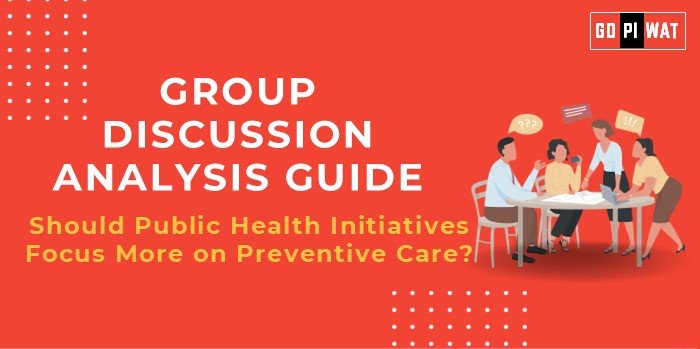📋 Group Discussion Analysis Guide: Should Public Health Initiatives Focus More on Preventive Care?
🌐 Introduction to Preventive Care
Opening Context: Globally, healthcare systems face rising costs and challenges due to preventable diseases such as diabetes, cardiovascular conditions, and certain cancers. Shifting focus to preventive care could save billions in healthcare spending while improving quality of life.
Topic Background: Preventive care refers to measures taken to prevent diseases rather than treating them after they occur. Efforts include vaccinations, health screenings, lifestyle counseling, and public awareness campaigns. Increasing focus on preventive measures could alleviate overburdened healthcare systems, particularly in countries like India, where 60% of deaths are attributed to non-communicable diseases.
📊 Quick Facts and Key Statistics
- 🌍 Global Spending: WHO estimates that a $1 investment in preventive care generates $4 in economic returns.
- 💔 Disease Burden: Non-communicable diseases account for 41 million deaths annually worldwide.
- 💸 Economic Impact: Chronic diseases could cost India $6 trillion by 2030 without intervention.
- 💉 Vaccination Success: Immunization prevents 3–4 million deaths globally each year, according to the CDC.
👥 Stakeholders and Their Roles
- Government Agencies: Frame and implement health policies, fund public awareness campaigns, and ensure vaccination access.
- Healthcare Providers: Offer screenings, consultations, and community outreach for early detection and prevention.
- Private Sector: Invest in health technologies, fitness programs, and workplace wellness initiatives.
- Citizens: Adopt healthier lifestyles, utilize preventive care services, and participate in community health programs.
✨ Achievements and Challenges
✅ Achievements:
- Polio eradication in India through vaccination campaigns.
- Global vaccination campaigns reduced infant mortality by over 50% in many regions.
- Increased screenings for diabetes and hypertension.
⚠️ Challenges:
- Accessibility: Preventive services are often unavailable in rural or underdeveloped areas.
- Awareness gaps: Many people are unaware of the importance of regular check-ups and vaccinations.
- Behavioral barriers: Resistance to lifestyle changes like smoking cessation or healthy eating.
Global Comparisons:
- Success Stories: Scandinavian countries have implemented robust preventive health strategies, resulting in lower healthcare costs and better health outcomes.
- Challenges in Developing Countries: Many nations lack infrastructure for widespread preventive care.
📖 Structured Arguments for Discussion
- Supporting Stance: “Prioritizing preventive care reduces long-term healthcare costs and improves public health outcomes.”
- Opposing Stance: “Preventive care cannot fully address health challenges without adequate curative infrastructure.”
- Balanced Perspective: “While curative care remains essential, preventive measures significantly enhance healthcare sustainability.”
💡 Effective Discussion Approaches
- Opening Approaches:
- Statistical Impact: “Non-communicable diseases account for 70% of deaths globally, most of which are preventable.”
- Solution Focus: “Countries that have invested in preventive care, such as Finland, show reduced hospitalizations and healthcare costs.”
- Counter-Argument Handling:
- Acknowledge existing curative needs but stress the cost-benefit of prevention.
- Highlight successful case studies like vaccination campaigns and workplace wellness programs.
🛠 Strategic Analysis of Strengths and Weaknesses
- Strengths: Cost-efficiency, improved population health, long-term economic benefits.
- Weaknesses: Initial investment challenges, lack of awareness, rural inaccessibility.
- Opportunities: Digital health platforms, AI in predictive diagnostics, and mobile health units.
- Threats: Resistance to change, funding limitations, and public distrust of health systems.
🏫 Connecting with B-School Applications
- Real-World Applications: Healthcare supply chain optimization, public health policy analysis, and innovative health tech solutions.
- Sample Interview Questions:
- How can preventive care reshape public health strategies in developing countries?
- What role do digital technologies play in enabling preventive healthcare?
- Insights for B-School Students:
- Explore innovative health financing models.
- Assess the role of corporate wellness programs in enhancing productivity.


